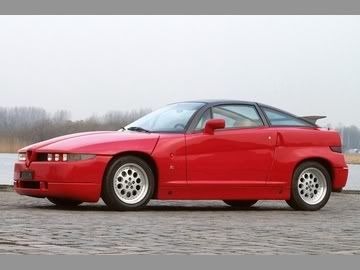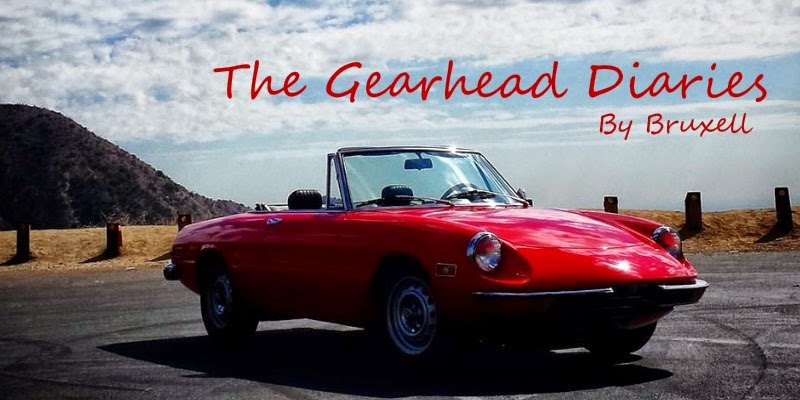 It seems like everyone, from Winding Road, to Evo, to my boss is absolutely gaga over Alfa's new super car and I can't say that I blame them. It's a beautiful car, and exclusive as well with only 500 units scheduled for production, expensive too at around $250,000. I don't really want to like this car as I don't think of it as a real Alfa Romeo, but as a Ferrari/Maserati hybrid with a serpent badge stuck on the front. That may not be an entirely fair description of the car as I'm sure that Alfa's engineers have done a lot of work to make their new version of the Ferrari/Maserati V8 work in the way they desire, and the Maserati Gran Turismo chassis has undergone significant revision aside from a fair bit of shortening up. Still, the fact that those items are on the car at all kind of irks me because, you see, I remember when Alfa were perfectly capable of making their own super cars from scratch.
It seems like everyone, from Winding Road, to Evo, to my boss is absolutely gaga over Alfa's new super car and I can't say that I blame them. It's a beautiful car, and exclusive as well with only 500 units scheduled for production, expensive too at around $250,000. I don't really want to like this car as I don't think of it as a real Alfa Romeo, but as a Ferrari/Maserati hybrid with a serpent badge stuck on the front. That may not be an entirely fair description of the car as I'm sure that Alfa's engineers have done a lot of work to make their new version of the Ferrari/Maserati V8 work in the way they desire, and the Maserati Gran Turismo chassis has undergone significant revision aside from a fair bit of shortening up. Still, the fact that those items are on the car at all kind of irks me because, you see, I remember when Alfa were perfectly capable of making their own super cars from scratch.It wasn't really all that long ago, maybe fifteen years, maybe a little more, shortly after the takeover by Fiat, that Alfa produced its last truly desirable car. It was called the SZ, for Sport Zagato and it was indeed Zagato who built the body, though it was designed Robert Opron at Fiat Design. It was a different sort of super car, on that harked to lightweight specials of the past not in style, but in substance. It was also a real Alfa, with it's power-train and underpinnings taken directly from the company's touring car version of the 75.

The styling would prove to be the car's calling card, and one of the limiting factors in its appeal. Very much in the angular mode of the time, it was however a stretch even for the customer of the late eighties raised on Mk I MR-2s and Lamborghini Countach posters. Its strange mix of straight lines and curves combined with slightly odd proportions to be punctuated by a distinctive, but challenging fascia. It wasn't pretty, but you could look at it for days without getting bored. Inside was a well trimmed, albeit spartan cabin, with a carbon-fiber fascia that was still novel at the time. the whole car was set off by a carbon spoiler at the back, and perhaps the most beautiful rendition of Alfa's traditional "phone-dial" alloys ever made.
The chassis was based on the floor pan of the 75 sedan, but suspension geometries were changed and the racer's coil springs replaced the torsion bars that dated back to the Alfetta. The suspension update, when combined with low-profile Pirelli P-Zero tires and the effects of aerodynamic downforce produced cornering power in excess of 1.4g, an impressive feat even today.
That cornering power did its best to compensate for the cars other weakness, its engine. There was nothing wrong with the 3.0liter V6, but in SOHC form it produced only 210bhp, a figure which was hardly going to set the world alight. What was often overlooked was that the car weighed in a 2769lbs (725lbs less than the 8C) which, while hardly making the car a lightweight, allowed it to scoot from 0-62 (with two people aboard) in about 7 seconds. Never intended to be a road burner the SZ was thus overlooked by many seeking more immediate thrills.
Alfa weren't looking to sell that many SZs though, only 1000 were scheduled to be produced, though a few more made it out the door before they were through. About 260 of the drop top RZ version were completed, out of a planned run of 350.
The 8C will be arriving in the U.S in a few weeks. They're already sold out, as they deserve to be. It is a beautiful car, with styling that cherry-picks its cues from the best of Alfa tradition, TZ-2, Stradale, and the original 6c Competizione coupe of the 50s. It will be fast, powerful and the cabin will delight owners with its dash machined from a billet of aluminum. I hear that Alfa's engineering staff have even sussed the automated transmission to the point that shifts are smooth and well timed.
But I can't help thinking that it won't be a real Alfa, no matter how I try to convince myself. It's been too long since Alfa gave up on making real driver's cars; they no longer possess the know how to develop from their own product line a car worthy of their own heritage and need the assistance of Ferrari and Maserati instead. So I'm still not sure what to make of the 8c. On one had it is a wonderful thing in and of itself, but on the other, it represents the decline of one of my favorite names in all of auto-dom. I can't wait to have the thrill of seeing and hearing one pass me on the road, but I know that when it does, I shall also feel just a little bit sad...









